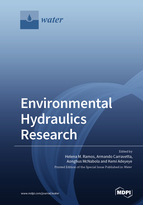Environmental Hydraulics Research
A special issue of Water (ISSN 2073-4441). This special issue belongs to the section "Hydraulics and Hydrodynamics".
Deadline for manuscript submissions: closed (31 July 2020) | Viewed by 69181
Special Issue Editors
Interests: hydropower; hydraulic transients; energy efficiency; eco-design projects; pumped-storage; water–energy–food nexus; hybrid energy solutions; renewable energy sources; energy recovery; hydrodynamics
Special Issues, Collections and Topics in MDPI journals
Interests: hydropower; efficiency of pumping systems; ecodesign of water pumps; water and energy nexus; fluid dynamics modeling
Special Issues, Collections and Topics in MDPI journals
Interests: energy efficiency in water systems; hydropower; heat recovery; air pollution control; fluid dynamics modelling
Interests: integrated design and planning; architectural technology; sustainability and resource efficiency (water); resilience in modern and heritage contexts; water resource efficiency; water, energy nexus
Special Issues, Collections and Topics in MDPI journals
Special Issue Information
Dear Colleagues,
This Special Issue aims to provide an international platform for the dissemination of research and engineering applications related to water and hydraulic problems. This issue welcomes papers in all topics of hydraulics, in particular, articles on sustainable water management, fluid–health issues, environmental hydraulics, ecohydraulics, water–food and energy nexus, systems efficiency. Safety and innovation issues are welcome too. Interdisciplinary problems and linkage of theory to experimental and field applications are particularly encouraged. Solutions of water problems are welcome in the form of prediction models, flow simulations, engineering systems, monitoring, management strategies covering scientific investigations and/or experimental or field studies of flow behaviour, hydrodynamics, and climate changes effects and adaptation, new design solutions, innovative approaches in the field of environment, hydraulics, techniques, methods, and analyses to address the new challenges in environmental hydraulics.
Prof. Helena M. Ramos
Prof. Armando Carravetta
Prof. Aonghus McNabola
Dr. Kemi Adeyeye
Guest Editors
Manuscript Submission Information
Manuscripts should be submitted online at www.mdpi.com by registering and logging in to this website. Once you are registered, click here to go to the submission form. Manuscripts can be submitted until the deadline. All submissions that pass pre-check are peer-reviewed. Accepted papers will be published continuously in the journal (as soon as accepted) and will be listed together on the special issue website. Research articles, review articles as well as short communications are invited. For planned papers, a title and short abstract (about 100 words) can be sent to the Editorial Office for announcement on this website.
Submitted manuscripts should not have been published previously, nor be under consideration for publication elsewhere (except conference proceedings papers). All manuscripts are thoroughly refereed through a single-blind peer-review process. A guide for authors and other relevant information for submission of manuscripts is available on the Instructions for Authors page. Water is an international peer-reviewed open access semimonthly journal published by MDPI.
Please visit the Instructions for Authors page before submitting a manuscript. The Article Processing Charge (APC) for publication in this open access journal is 2600 CHF (Swiss Francs). Submitted papers should be well formatted and use good English. Authors may use MDPI's English editing service prior to publication or during author revisions.
Keywords
- computational fluid dynamics
- sustainability and efficiency
- ecohydraulic engineering and ecosystem
- new design solutions
- hydrodynamics
- urban water bodies
- rural innovative solutions
- integrated modelling
- water systems flexibility with nature









